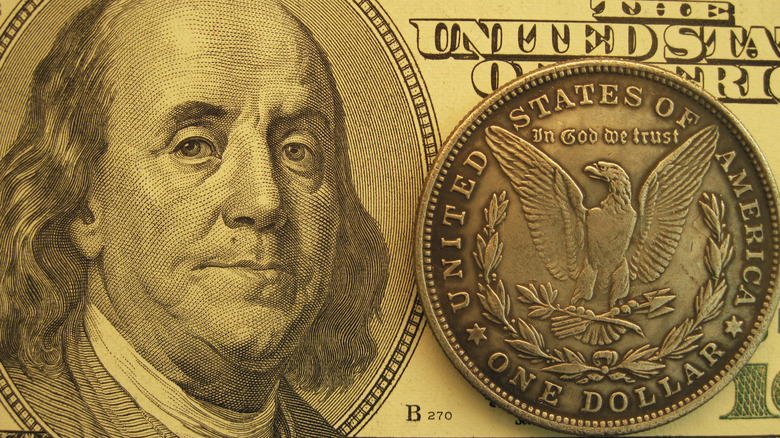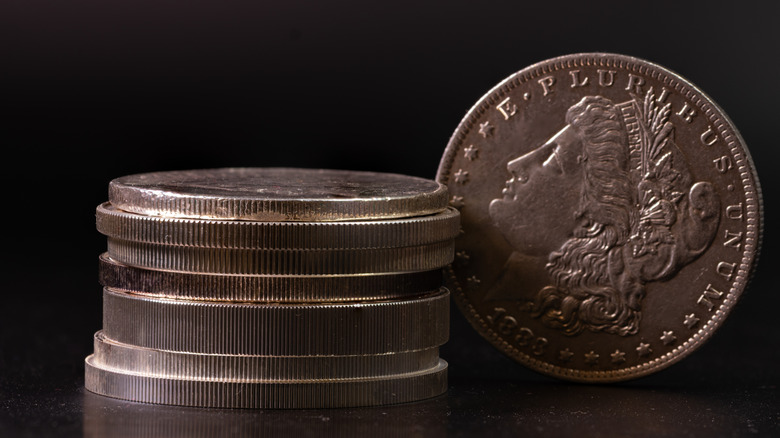The Rare Silver Dollar Coin That Could Earn You $2 Million
In the modern age of digital transactions where cash is steadily becoming an antiquated form of payment, you probably don't find use for pocket change that often. However, getting your hands on a rare coin can change your life. Such is the case with a very rare silver dollar that's worth — you guessed it — a lot more than a dollar.
Designed by engraver George T. Morgan, the Morgan dollar was minted from 1878 to 1921 (with a prolonged pause in production from 1905 to 1920). So, if you encounter one, you bet your bottom dollar it's over a hundred years old. While such a coin produced in any year is a coveted find amidst collectors, a Morgan coin minted in 1893 is particularly valuable. By all physical counts, it's no different than those minted in previous years. But a significant economic downturn in the United States that year resulted in the smallest batch of the Morgan dollar ever produced, making the 1893-S Morgan silver dollar the rarest and most valuable coin in the century-old series.
What makes the 1893-S Morgan silver dollar so rare?
At the time that the 1893-S Morgan silver dollar was minted, the United States was in the throes of an economic depression known as the Panic of 1893. Lasting from May to November, historians trace the origins of the financial downfall to the 1890 Sherman Silver Purchase Act, which resulted in gold being 16 times more valuable than silver. This led to a desperate increase in silver production and a further decline in its value. Due to the panic, only 100,000 Morgan dollars were produced in 1893 before the U.S. Mint halted silver currency production, temporarily switching to gold coins to support the current state of the economy.
With an already small batch to begin with, the Pittman Act of 1918 — an act that resulted in the melting of Morgan dollars in order to salvage silver — shrunk the total number of 1893-S Morgan silver dollars from 100,000 even more. The coin's scarcity makes it a prized jewel in numismatics, and its price can range from $3,000 to over $1 million. Of course, the Mint State (MS) of a coin comes into play when determining its value. To date, the most pristine 1893-S Morgan silver dollar was graded MS-67 (on a 70-point scale), and sold at auction in 2021 for a whopping $2.1 million. If you're lucky enough to come across one of these precious silver coins in exceptional condition, it just might make you a millionaire.
How to identify an authentic 1893-S Morgan silver dollar
Of course, a coin with such a staggering value is bound to inspire counterfeits, making it exceedingly important to get your coins analyzed by a professional grading firm. To check for counterfeit clues on your own, the Numismatic Guaranty Company (NGC) — an expert coin grading company since 1987 — recommends paying close attention to the "S" mintmark. Signifying the city the coin was minted in (in this case, San Francisco), that tiny letter is crucial to the coin's value. Since many Philadelphia coins aren't branded with a mint mark, counterfeiters are notorious for adding the "S" to unmarked coins in attempts to disguise them as the highly profitable 1893-S Morgan silver dollar. If you suspect a counterfeit, NGC says to "check for tool marks and discoloration around the mint mark," either of which suggest that the letter "S" may have been added to the coin.
Weight is also a good indicator of a fake. Composed of 90% silver and 10% copper, an authentic 1893-S Morgan silver dollar weighs precisely 26.73 grams, per the Professional Coin Grading Service (PCGS). If the weight is off by 0.1 grams or more, it can signal a forged coin. Since silver is not magnetic, a simple magnet test can come in handy as well. As a basic rule of thumb, if it sticks, it's not legit. According to both the NGC and the PCGS, neatly reeded edges (or a lack of them altogether) are also signs of a counterfeit. Furthermore, Coin World heeds collectors to closely examine the date on the coin. If the "3" in 1893 looks slightly taller than the other numbers, it's likely been tampered with. Suffice to say, when dealing with extremely rare coins, it's extremely important to confirm that all the details are authentic. Otherwise, instead of striking gold (or silver), you may sadly strike out.


